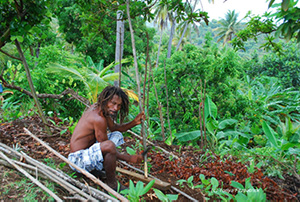Norwegian Divers are Turning Invasive Sea Urchins Into Colorful Lights

Sea Urchins in the Kelp Forest Courtesy of Lofotlys and Max Emanuelson
Posted August 19, 2024
North of the Arctic Circle, Norway’s Henningsvær plays to the strengths of its surroundings. Framed by dramatic, jagged mountains and the icy Norwegian sea, this Lofoten fishing village attracts hikers, climbers, cold plungers, and divers alike.
Two of these divers — Norwegian couple Matias Nordahl Carlsen and Alexandra Anker — repeatedly zip up their dry suits for more than just sport. Since the pandemic, Carlsen and Anker have been repurposing self-collected sea urchins into colorful table lamps. The idea began when Anker accidentally illuminated a decorative sea urchin with her phone flashlight while working at Henningsvær Bryggehotell. The result? Lofotlys, which serves a role in both Henningsvær’s business ecosystem and Norway’s environmental one.

Preparing for Sea Urchin Dive Courtesy of Lofotlys & Max Emanuelson
The Problem with Sea Urchins
“The problem with the sea urchins is that they eat up all the kelp forests,” explains Lofoten-raised Carlsen. (Anker moved to the Lofoten Islands from Oslo.) “The kelp forest does the same job as the rainforest, but nobody knows about it.”
Across global waters, kelp produces oxygen and sequesters carbon dioxide. It therefore fights climate change while preserving biodiversity. Over the last few years, however, sea urchins have surged, perhaps most notably in California. As of 2021, invasive urchins had destroyed more than 95% of the state’s coastal kelp, according to The New York Times.
“The scale of macroalgae loss [in Norway] is significantly greater than even in California,” said Philip James, a senior scientist at Norwegian food research institute Nofima.

Sea urchin in the waters of Northern Norway Courtesy of Lofotlys and Max Emanuelson
Addressing the Sea Urchin Problem One Lamp at a Time
Lofotlys is addressing that urchin problem one lamp at a time. Kelp forests are regenerative — so long as the urchins disappear. Anker and Carlsen don’t target any one place for urchin removal, but, instead, dive five to ten meters deep into the waters surrounding their Henningsvaer shop. To transform their retrieved urchins into lamps, they clean them with fisherman gloves, remove all the spikes, and drill a light-sized hole beneath each one.
Carlsen and Anker then repeat this process throughout the year. But while they’re in the business of creating lights, they can’t combat the dark season. The onset of the Arctic’s polar night condenses the window for urchin harvesting, creating an idiosyncratic set of difficulties for Scandinavia’s divers.
Yet even under the midnight sun, harvesting remains a challenge, thanks to Norway’s lack of commercial urchin fisheries and unique waters. “Unlike California, Norway has never had a commercial fishery for sea urchins,” said James, who pinpointed the expenses of tank diving and corresponding regulations and restrictions. Likewise, many innovative harvesting techniques work on sea floors with flat bottoms, while Norway’s urchins lurk on complex substrates, close to shore.
“Even if you’re successful extracting that sort of quantity of sea urchin, then you still got to figure out what you’re gonna do with it once you get it on shore,” said James.

Lights created from Sea Urchins Courtesy of Lofotlys & Max Emanuelson
An Aesthetic Solution to Excessive Sea Urchins
In California, that solution seems to be culinary; chefs have added sea urchins to their menus. Nearly 5,000 miles away, however, Lofoten’s solution appears to be aesthetic. In addition to Loftlys, Lofoten’s Nyt Lofoten sells urchin tea lights, while various businesses across the islands have leveraged urchins as decor. Meanwhile, volunteer groups across Norway, such as Tromsø’s Tarevoktere, focus fully on urchin harvesting.
“There’s some really good efforts being done on both those sort of community level[s] and a small industrial scale,” said James. “But when you look at the scale of the problem in Norway, it’s a drop in the ocean.”
According to estimates, Norway’s coast houses some 80 billion sea urchins. Ideally, that sea urchin density would be reduced to one urchin per square meter, said James, citing emerging research from his home country of New Zealand. Without that density, the seaweed won’t return.
“Although we haven’t seen a decrease in the number of sea urchins, we have seen that, in some areas, the kelp forest has started to grow back,” said Carlsen, pointing to the impact of Lofoten’s collective efforts to address the problem. He acknowledges that Lofotlys neither collects nor sells enough lights to make the desired impact. But the scale of any one effort isn’t necessarily the point.
“The fact that we are making our customers aware about this and we are spreading the information, I think, has a bigger impact,” said Carlsen.
Click Here for Discounted Accommodations in the Lofoten Islands, Norway.
Join the community!

Join our community to receive special updates (we keep your private info locked.)




